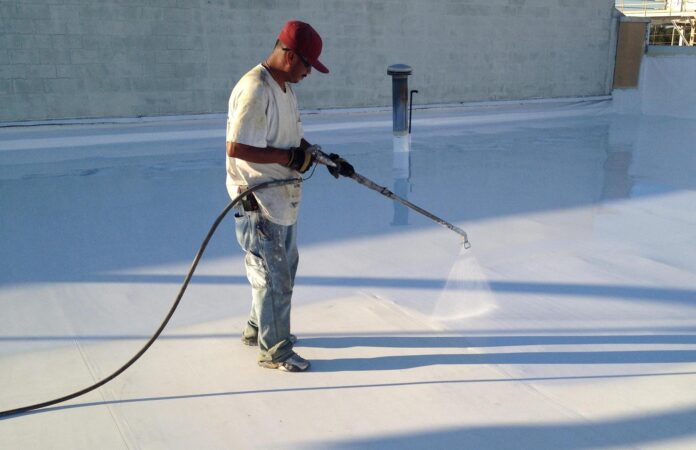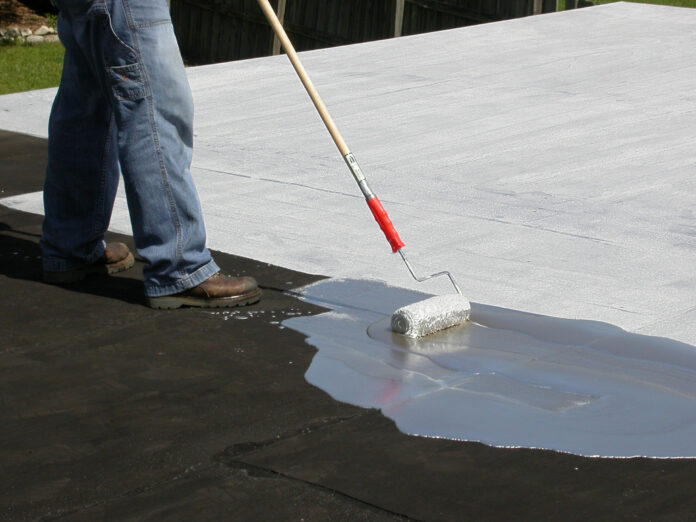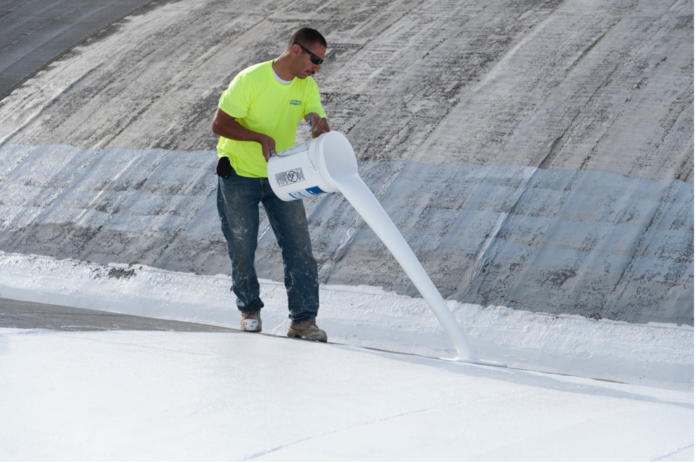Commercial roof coatings have the capability to prolong the lifespan and enhance the visual appeal of low-slope roofs. In its role, a roof coating functions as the initial protective layer against UV damage and water infiltration. Furthermore, the Benefits Of Commercial Roof Coatings include lowering the roof’s temperature. This article aims to equip readers with comprehensive knowledge about commercial roofing, covering topics ranging from diverse roofing materials to some fantastic benefits.
Basics of Commercial Roof Coatings

Commercial roof coatings, resembling paint but thicker, can be applied with various tools like sprayers, brushes, or rollers. They form a flexible barrier, protecting against water, weather, and UV damage. However, severe damage or specific conditions may require a total roof replacement, rendering commercial roof coatings ineffective.
Types of Roof Coatings Used in Commercial Purposes
Before discussing the Benefits Of Commercial Roof Coatings, it is essential to know about the different categories of roof coatings available in the market. The following are some basic categories one can find easily.
- Silicone coating: Silicone roof coating, known for its reflectivity and strong UV resistance, demonstrates superior performance compared to acrylic coatings, particularly in regions with heavy and persistent rainfall. This type of coating is applied in areas characterized by daily rain, where roofs frequently become wet and experience ponding water.
- Polyurethane coating: Polyurethane coatings are generally solvent-based and are available in two primary varieties: aromatic and aliphatic. The latter variant demonstrates UV stability. Urethane exhibits favorable mechanical characteristics, including high abrasion resistance and tensile strength. These coatings find their optimal application in regions prone to hail in the Western United States and in areas with surfaces subjected to significant foot traffic.
- Acrylic coating: Acrylic coatings, being water-based, possess inherent reflectivity and UV resistance. They exhibit versatility in their ability to be applied to a wide range of roofing types, encompassing built-up roofs, modified bitumen, concrete, spray polyurethane foam, PVC, and metal roofs.
Choosing the Right Commercial Roof Coating

Selecting the appropriate commercial roof coating is crucial to ensure long-term benefits. Factors like climate, building type, and budget play a significant role in this decision. Consult with a roofing professional to determine the most suitable coating for your specific needs. Keep in mind that the wrong choice can lead to premature coating failure and the need for costly reapplication.
Maintenance and Longevity
Maintenance and longevity are pivotal aspects of a successful commercial roof coating strategy. Proper upkeep plays a significant role in ensuring the longevity of your investment. Regular inspections, cleaning, and minor repairs are essential to extend the lifespan of the coating. This preventative approach helps identify potential issues early, preventing them from developing into more extensive and costly problems.
A well-maintained commercial roof coating can endure for a considerable period, typically ranging from 10 to 25 years or even longer, depending on factors such as climate and the coating type used. Consistent maintenance not only safeguards your roof but also preserves its energy-saving benefits and aesthetic appeal.
Incorporating maintenance into your roof coating plan is a cost-effective measure that ultimately protects your bottom line. By prioritizing upkeep, you can maximize the return on your roofing investment while ensuring a reliable and durable protective barrier for your commercial property.
Benefits of Commercial Roof Coatings

Commercial roof coating safeguards the roof membrane against UV rays and adverse weather conditions. It establishes a waterproof barrier on the pre-existing flat roof while enhancing the roof system’s fire resistance. The application of this coating has the potential to augment the surface’s reflectivity, thereby alleviating the stress on the building’s heating and cooling systems. The benefits are discussed in more detail below:
1. Improve aesthetic appeal:
When a newly applied commercial roof coating is in place, it offers a pristine, seamless look that has the potential to enhance the aesthetic and curb appeal of one’s property, all the while safeguarding the underlying roof system.
2. Potential savings for cooling:
A dark-colored roof can achieve temperatures exceeding 150°F, whereas a white roof exhibits greater reflectivity, potentially reducing surface temperatures by 50°F or more. The installation of a white reflective roof coating on a commercial building has the potential to yield savings on cooling expenses.
Environmental Benefits
Aside from the economic advantages, commercial roof coatings offer environmental benefits as well. By reducing the need for frequent roof replacements and lowering energy consumption due to increased reflectivity, these coatings contribute to a more sustainable building environment. Reduced energy use can also lead to lower greenhouse gas emissions, making them a viable option for eco-conscious businesses.
Application Process
The application process is a critical step in harnessing the full potential of commercial roof coatings. It requires precision and expertise to ensure the coating adheres properly and provides the expected benefits. The process typically begins with thorough cleaning and preparation of the existing roof surface, removing any debris, dirt, or loose materials.
After preparation, the coating is applied in multiple layers, following the manufacturer’s guidelines and specifications. Each layer must be uniform and properly cured to achieve the desired protective properties. The application process may also involve addressing any existing roof damage or defects to ensure a seamless and robust protective barrier.
Professional installation by trained roofing experts is crucial to a successful application. Additionally, specific coating types may require specific environmental conditions, such as temperature and humidity levels, for optimal results.
A well-executed application process ensures the coating’s longevity and performance, providing your commercial property with reliable protection against UV rays, weather, and water infiltration while maximizing energy efficiency and aesthetic appeal.
Cost Considerations
While commercial roof coatings offer numerous benefits, it’s essential to consider the upfront costs. The price of materials, labor, and preparation can vary significantly depending on the type of coating and the condition of your existing roof. However, it’s essential to view these costs as an investment that can lead to long-term savings in energy bills and reduced maintenance expenses. A professional roofing contractor can provide a detailed cost estimate tailored to your specific project.
Conclusion
The article has provided a detailed guide about what is commercial roof coating, its types, and the Benefits Of Commercial Roof Coatings. However, to ascertain which commercial roof coating offers the optimal return on investment for the circumstances, it is advisable to consult with an experienced contractor.









